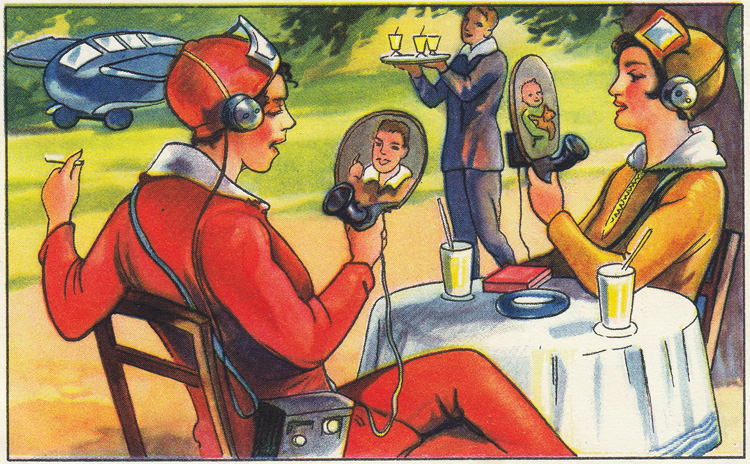Yuk Hui, Andreas Broeckmann (eds.): 30 Years After Les Immatériaux: Art, Science and Theory (2015)
Filed under book | Tags: · art, art history, art theory, communication technology, media, postmodernity, technology

“In 1985, the French philosopher Jean-François Lyotard curated a groundbreaking exhibition called Les Immatériaux at the Centre Pompidou in Paris. The exhibition showed how telecommunication technologies were beginning to impact every aspect of life. At the same time, it was a material demonstration of what Lyotard called the post-modern condition.
This book features a previously unpublished report by Jean-François Lyotard on the conception of Les Immatériaux and its relation to postmodernity. Reviewing the historical significance of the exhibition, his text is accompanied by twelve contemporary meditations. The philosophers, art historians, and artists analyse this important moment in the history of media and theory, and reflect on the new material conditions brought about by digital technologies in the last 30 years.”
Texts by Daniel Birnbaum, Jean-Louis Boissier, Andreas Broeckmann, Thierry Dufrêne, Francesca Gallo, Charlie Gere, Antony Hudek, Yuk Hui, Jean-François Lyotard, Robin Mackay, Anne Elisabeth Sejten, Bernard Stiegler, and Sven-Olov Wallenstein.
Publisher meson press, Lüneburg, Jun 2015
Creative Commons BY-SA 4.0 License
ISBN 9783957960313
245 pages
Reviews: Ellef Prestsæter (Kunstkritikk, 2015), Neural (2016), Michela Alessandrini (Critique d’art, 2017, FR).
Comment (0)Echte Wagner Margarine, Album 3, Serie 12-13: Zukunftsfantasien (c1930)
Filed under artist publishing | Tags: · communication technology, science fiction, television, transport
This image comes from a set of collectible cards issued by the margarine factory Wagner & Co. in the northern German town of Elmshorn, circa 1930. The album is arranged in 36 series of 6 cards each; two of them (12-13) are titled “Zukunftsfantasien” [Fantasies about the Future]. The author of the cards is unknown.
The caption under the image reads: „Drahtloses Privattelefon und Fernseher. Jeder hat nun sein eigenes Sende- und Empfangsgerät und kann sich auf einer bestimmten Welle mit Bekannten und Verwandten unterhalten. Aber auch die Fernseh-Technik hat sich so vervollkommnet, daß man dem Freunde gleichzeitig ins Angesicht schauen kann. Sende- und Empfangsgerät sind nicht mehr an den Ort gebunden, sondern werden in einem Kasten von der Größe eines Photoapparates immer mitgeführt.“
Publisher Heinz Wagner / Holsteinsche Pflanzenbutterfabriken Wagner & Co., Elmshorn in Holstein, c1930
1 of 18 nonpaginated cardboard sheets
HT RidT
Low resolution JPGs (via)
View online (cards only, on Retro-Futurism.de)
Cards assembled into PDF (via)
Letters of Marshall McLuhan (1987)
Filed under book | Tags: · biography, communication technology, language, literary theory, mass media, media, media theory, print, technology, television

McLuhan corresponded with a vast number of people, including Duke Ellington, Woody Allen, Jacques Maritain, Rollo May, Susan Sontag, Eugene Ionesco, Wyndham Lewis, Ezra Pound, Bob Newhart, Hubert Humphrey and Jimmy Carter.
Heavily annotated, the letters are arranged in three sections, each with a period introduction: 1931-1936 takes McLuhan through the University of Manitoba and Cambridge University. 1936-1946 covers one year’s teaching at the University of Wisconsin; two years at Saint Louis University; one year, with his bride, at Cambridge for work on his Ph.D.; four more years at Saint Louis; and two years as Assumption College, Windsor, Ontario. These letters include a large correspondence with Wyndham Lewis. The last section begins in 1946, when McLuhan went to the University of Toronto. Two years later he began a long correspondence with Ezra Pound. Covering the period of McLuhan’s fame, it ends in September 1979 with a letter to Pierre Elliott Trudeau, written shortly before McLuhan had a stroke that rendered him speechless.
These letters have been selected from a large collection, now in the Public Archives of Canada, and offer a valuable commentary on McLuhan’s work and, in some instances, the most lucid and detailed explanation of his ideas available.
Selected and edited by Matie Molinam, Corrine McLuhan, and William Toye
Publisher Oxford University Press, 1987
ISBN 0195405943
562 pages
Review (R.D. Berg, Canadian Journal of Communication, 1988)
Review (Frank Kermode, London Review of Books, 1988)
PDF (189 MB, no OCR, any help in reducing the size is welcome!)
Comment (1)

